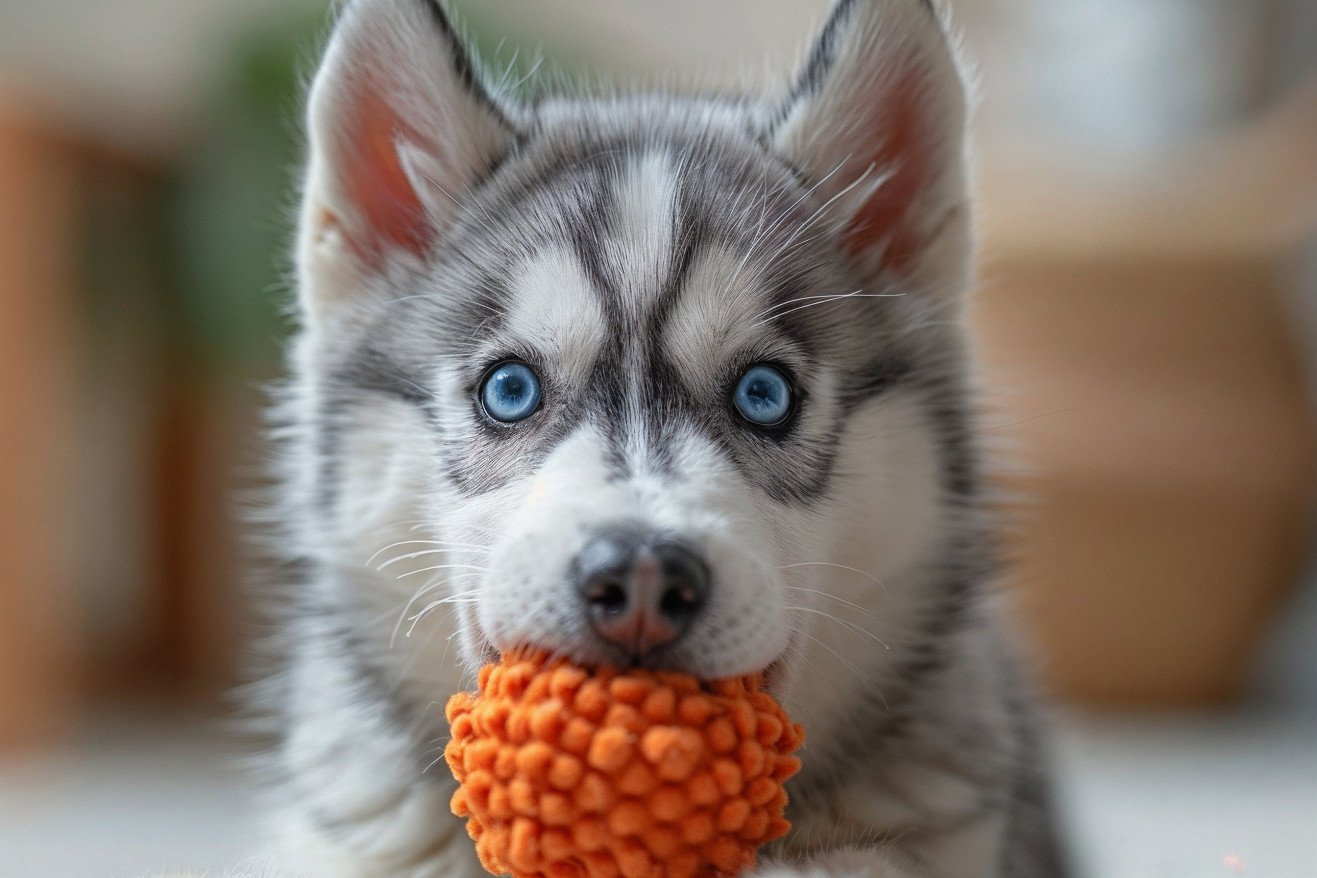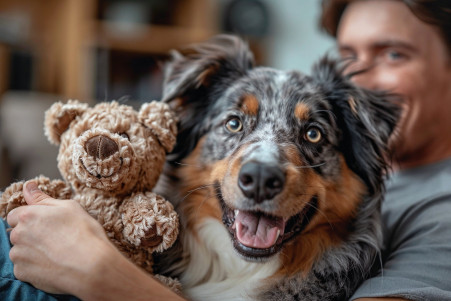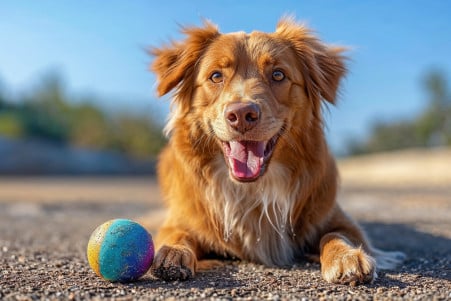Why Do Dogs Shake Their Toys? Exploring Canine Behavior
9 May 2024 • Updated 9 May 2024

Have you ever wondered why your dog seems to be shaking their toys to death? Sometimes with reckless abandon? The act of shaking and whipping their toys around is a way for dogs to simulate the killing bite they would use when hunting prey in the wild - it helps them hone their predatory skills and ensures they get the physical and mental stimulation they would get from hunting.
Although it may be confusing, funny, or even annoying, this article will take a deep dive into the psychology behind this popular dog behavior. Drawing on scholarly studies in animal behavior, evolutionary biology, and comparative psychology, we will explain the instinctual motivations and evolutionary benefits that lead dogs to shake their toys with such gusto.
Why do dogs shake their toys?
Breed Differences: Genetic Predisposition to Toy Shaking Behaviors
Some dog breeds are more likely to shake their toys more often or more vigorously due to their genetic makeup. Terriers and other hunting dogs, such as Jack Russell Terriers and Dachshunds, have a strong genetic predisposition to shake their toys with great enthusiasm. As a result of their breeding, these dogs have a strong "shake-to-kill" instinct, which they express when they play with toys, according to PetsRadar.
Meanwhile, northern breeds like Huskies and Malamutes, which are more closely related to wolves, also shake their toys more than other dogs because of their wolf-like genetics and predatory nature. These breeds have retained many of the hunting instincts of their wild ancestors.
On the other hand, gundogs like Labradors and Golden Retrievers are less likely to shake their toys with great intensity. According to PetsRadar, these breeds were bred to have a "soft mouth" to avoid damaging game, which reduced their shake-to-kill drive.
In the end, breed differences in prey drive and other hunting instincts play a big role in how much dogs shake their toys. Some breeds have been bred for generations to increase these instincts, while others have been bred to reduce them.
The Prey Drive Connection: Why Dogs Shake Their Toys
A dog's prey drive, or the instinct to chase, capture, and kill prey, is responsible for a dog's toy shaking behavior. Bored Panda notes that when dogs shake their toys, they are participating in a "simulated hunting exercise" because the suspense, leap, and satisfying sound are reminiscent of their experience as hunters in the wild.
Dogs with a high prey drive are more likely to engage in the full predatory sequence, which includes shaking and dismembering toys. PetMD explains that the "chase-capture-kill sequence" is a pattern of instinctive behaviors that dogs use to catch and eat their prey, even if they are domesticated. Shaking toys helps dogs fulfill their need to participate in these predatory behaviors.
Providing dogs with the right toys and opportunities to express their prey drive can help prevent destructive or dangerous behaviors. The Owner's Guide from Holiday Barn notes that "controlled play sessions involving toy shaking can be a healthy way to channel a dog's natural hunting instincts." This enables dogs to fulfill their predatory needs in a safe way.
From Wolves to Pets: The Evolution of Toy Shaking Behavior
The domestic dog's toy shaking behavior can be traced back to wolves, which shake their prey to kill it. According to the Bark, wolves engage in the full predatory sequence for survival, while dogs exhibit fragments of this behavior during play. Humans have also played a role in the development of toy shaking through selective breeding, which has led to variations in the behavior among different dog breeds.
For example, some breeds like Greyhounds have been selectively bred to enhance specific predatory behaviors for hunting. As reported by Proud Dog Mom, the Greyhound's strong toy-shaking behavior is an extreme version of the predatory behavior exhibited by their wolf ancestors. Meanwhile, other breeds have been selectively bred to have a softer bite and lower prey drive, which has made them less likely to shake their toys.
The result is that the evolutionary path from wolves to pets has led to a wide range of expressions of this instinctual behavior in dogs. This is important for dog owners to understand so they can appreciate and manage their dog's play behavior accordingly.
How to Stop Toy Shaking: Training and Behavior Modification
While toy shaking is a normal part of a dog's play behavior, it can become a problem if it leads to destructive or dangerous behaviors. The Humane Society of the United States explains that positive reinforcement training can be used to train dogs to play more gently with toys and to respond to commands like 'drop it'. This means that the dog is immediately rewarded for the behavior, like sitting or lying down, and then asked to do the command.
Providing appropriate outlets for the behavior, such as playing tug-of-war or using puzzle toys, can also help dogs satisfy their prey drive in a way that's safe for everyone involved. DeMaris Dog Training explains that tug play should be done safely on non-slippery surfaces, the dog should be doing most of the work, and the dog should be allowed to win at least some of the time.
If there are other issues at play, like boredom or frustration, these can be addressed to help reduce the amount of toy shaking that a dog is doing. In more extreme cases, Whole Dog Journal explains that a professional dog trainer or behaviorist may be needed to help modify the behavior using techniques like capturing, shaping, or prompting.
Conclusion: Embracing the Primal Playfulness
The Woof Report offers further evidence of the evolutionary roots of this behavior, explaining that the consensus among experts is that the roots of toy shaking lie in the predatory instincts of dogs' wolf ancestors. According to the Woof Report, even though dogs have been domesticated, they still have a natural prey drive that they express through play.
The Woof Report goes on to say that the way dogs express this instinct is similar to how wild dogs and wolves would kill small prey, which is to shake it to break its back quickly. So when dogs shake their toys, they are essentially "killing their prey," and the way they do it is a holdover from the way their wolf ancestors hunted.
Embracing a dog's primal playfulness will also help owners better understand and appreciate their pets' unique behaviors and their connections to their ancient ancestors.


